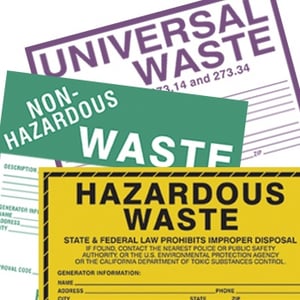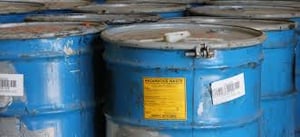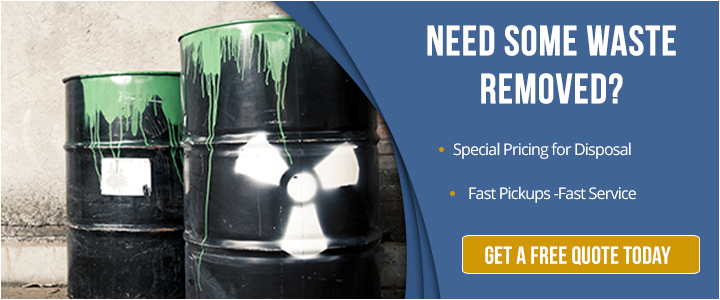Hazardous waste labels are critical to ensuring the safety of workers and avoiding costly fines.
That’s why knowing where to find them - and the information they should contain - is crucial. Improper labeling can lead to costly violations of strict state and federal waste management guidelines. Yet many companies do not follow hazardous waste label requirements.
In fact, improper labeling is one of the most frequent violations issued.
Despite the importance of hazardous waste labels, however, there is no need to waste money ordering them online and waiting for them to ship. Instead, free hazardous waste labels are offered online and can be downloaded and printed at your convenience or when the need arises.
In other words, buying a standard office label and slapping it on to your hazardous waste drum simply won’t do, and in the end, can cost you significantly more than a free label available with the click of a mouse.
Below we’ll share where to find free printable hazardous waste labels and what you should look for to determine whether they meet federal and state regulations.
Where To Get Free Printable Labels
 While several sites offer pre-printed labels, these can be costly and inconvenient, especially if you need the labels quickly.
While several sites offer pre-printed labels, these can be costly and inconvenient, especially if you need the labels quickly.
You can help ensure your compliance right away, however, by using IDR’s free hazardous waste labels on your storage containers.
These labels are compliant with Environmental Protection Agency (EPA) and the Department of Transportation (DOT) regulations. Simply download the label and print it out. After filling in the correct information, which we will explore in the next section, attach the label to a storage container.
There are several other sites online that offer free labels as well. However, with any site you download labels from or make a purchase from you should ensure the labels you choose are in compliance with EPA and DOT regulations.
What Labels Should Include
Before you download a printable hazardous waste label, it’s important to understand what elements the label should include so that you can ensure you company is in compliance with any labeling requirements.
Here is where hazardous waste labeling can get tricky. Depending on where you are located, you may have local and state requirements you must follow - in addition to what is set forth by the EPA and DOT. Even certain industries may require or suggest additional information on a label.
It’s critical that you know any label requirements for your particular state and municipality.
Here is some of the information you will need to know and provide on a hazardous waste label:
- Generator information, such as name, address and phone number
- EPA ID number and a manifest tracking number
- EPA waste number and, if in California, a California waste number
- An accumulation start date
- Contents and their composition
- The physical state of the contents
- Hazardous properties (flammable, toxic, corrosive, reactivity, etc.)
- The DOT proper shipping name
Our articles, Hazardous Waste Label Requirements You Need To Know and How To Label Hazardous Waste, go into much further detail about label requirements and standards set forth by the:
- California Department of Toxic Substances Control
- U.S. Department of Transportation
- Environmental Protection Agency
- Additional industry best practices
It’s important to mention as well that best practice calls for personnel to use the same method to label containers. This may include the use of prepared labels. Downloading the same hazardous waste label and using it on all of your drums and containers will provide consistency and help ensure employees are familiar with the label they are completing.
Where Labels Should Go
 Where labels are placed on the container after you download and print them also is regulated.
Where labels are placed on the container after you download and print them also is regulated.
In general, labels must appear in their entirety and should not be placed near any other markings or labels to avoid being missed.
For example, the DOT recommends a 6-inch space between labels if there are more than one on a container. The primary hazard label should also be placed above and to the left of the subsidiary hazard label.
Labels should not be placed on the bottom of containers (where they can be missed), and workers should remove any old labels before reusing containers. In some cases, you can use a “recurring use label” to revise information on the labels as needed, such as the initial accumulation date. (Workers should place labels on the containers or update the initial accumulation date when waste if first placed in the container.)
Other Best Practices For Hazardous Waste Labels
Where labels are placed on hazardous waste containers and the information they include aren’t the only considerations when choosing printable labels.
There are several best practices your employees should be aware of when marking your containers. Often, these best practices relate to the labels themselves, so it’s important to choose wisely since there are several options available to you.
-
All personnel should use the same method to label containers. This may include handwritten or prepared labels, for example. If you select multiple types of labels, this could add confusion to the process you put into place.
-
Use clear and legible language. The label should clearly communicate the nature and degree of hazard posed by the waste. It’s helpful to choose a label that has a clear and distinct area for addressing these hazards.
-
Use durable materials. The label should be in good condition and made from durable materials that can withstand the conditions in which the waste will be stored and transported.
-
All waste handlers should be properly trained. Training should include understanding what markings on the labels mean. Although hazardous waste labels may include most of the same information, how they are designed may vary.
-
Consistency is key. It is important to ensure that all waste containers are labeled in the same manner to minimize confusion and reduce the risk of mistakes. Using a certain type of label consistency can help reduce the risk for confusion.
Keep in mind that regulations are continually evolving. Labeling requirements for hazardous waste can change over time, so it’s important to stay informed of any updates to ensure that the waste is properly labeled.
Don’t Forget Hazmat Placards
An important part of labeling hazardous waste is including hazmat placards on the packaging. Hazardous materials, or hazmat, placards are signs that are placed on the exterior of vehicles, containers or packages. These placards indicate the presence of hazardous materials during transportation.
Placards also provide visual warnings to emergency responders, transport workers and others about the potential hazards associated with the materials being transported. The United States Department of Transportation (DOT) uses a standardized system for hazmat placards to identify the types of hazardous materials being transported.
There are nine categories of hazardous materials, each of which is identified by a unique color and symbol. Here are the nine different hazmat placards:
- Explosives: Orange placard with an exploding bomb symbol
- Gasses: Various colors with a symbol representing the specific type of gas being transported, such as a flame for flammable gas or a cylinder for compressed gas
- Flammable liquids: Red with a flame symbol
- Flammable solids: Red, blue, or red and white strips with a flame symbol and combustible notation
- Oxidizers and organic peroxides: Yellow, or yellow and red, with a flame symbol over a circle
- Toxic and infectious substances: White with a skull and crossbones symbol
- Radioactive materials: White with a yellow trefoil symbol
- Corossives: White, or white and yellow, with a black “corrosive” symbol that shows a substance spilling onto a hand
- Miscellaneous dangerous goods: Black and white vertical stripes
In addition to the symbols, each hazmat placard also includes a four-digit identification number that corresponds to the specific material being transported. This helps emergency responders identify the hazards and take appropriate action in the event of an accident or spill.
To obtain a hazmat placard, you can download a free sign ready to print from IDR. You can also purchase hazmat placards from a variety of sources, including online retailers, specialty suppliers and transportation supply companies. It is important to ensure that the placards you purchase meet the DOT requirements, including the correct size, color and symbol for the specific type of hazardous material you are transporting.
Bottom Line
Following proper procedures to be in compliance and ensure the safety of your employees doesn’t have to be costly.
In fact, hazardous waste labels that offer information regulated by state and federal governments can quickly be found on the internet, downloaded and printed for the cost of the ink and paper used.
IDR’s free hazardous waste labels help you comply with state and federal regulations put into place to maintain a safe workplace and community.


Comment